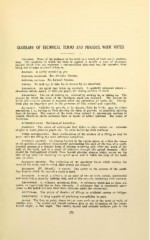Page 431 - My FlipBook
P. 431
GLOSSARY OF TECHNICAL TERMS AND PHRASES, WITH NOTES
Abrasion. Wear of the surfaces of the teeth as a result of their use in mastica-
tion. The condition to which the term is applied is usually a wear of abnormal
amount which does not represent a corresponding abnormal use, the excessive wear
being due to some unknown influence.
Abscess. A cavity containing pus.
Abscess, alveolar. See Alveolar Abscess.
Abscess, lateral. See Lateral Abscess.
Absorb. To suck up, to take in, to remove by an absorbent.
Absorbent. An agent that takes up moisture. A specially prepared cotton —
absorbent cotton, spunk, or bibulous paper, for drying cavities in teeth.
Absorption. The act of sucking in ; removal by sucking in, or taking up. The
process by which the roots of the deciduous teeth are removed. The process by
which the alveolar process is removed after the extraction of teeth, etc. Absorp
tions play an important part in the processes of life, animal and vegetable.
Accretion. Addition by growth, or by deposit, little by little; may be either
amorphous, i. e., leaving no lines showing the form of growth; or stratified, showing
lines of increase. The enamel of the teeth when reduced to microscopic sections in
certain directions shows accretion lines or layers of added material. See Lines of
Accretion.
Accretion lines. See Lines of Accretion.
Adhesion. The union of substances that differ in their nature, as: adhesion
of glue to wood, paste to paper, etc. To unite bodies by their surfaces.
After condensation. Such condensation of the surface of a filling as may be
made after the filling has been otherwise completed.
Alveolar abscess. An abscess located in the apical space, or within the tissue
of the peridental membrane immediately surrounding the apex of the root of a tooth.
Alveolar abscess is a distinct form of abscess occurring only after the death of the
pulp of the tooth, and is a result of infection through the apical foramen. This
should be distinguished sharply from lateral alveolar abscess which occurs on the
side of the root, not involving the apical space and in which the pulp of the tuoth
may be alive.
Alveolar process. The projection of the maxillary bones which envelop the
roots of the teeth, and in which their alveoli are formed.
Alveolus. (PI. Alveoli). A socket: The cavity in the process of the maxil-
lary bone in which the root of a tooth is fixed.
Amalgam. A metal, a mixture, or an alloy of two or more metals, comminuted
and made into a mass by rubbing with, and in this manner, combining with mercury.
Amorphous. A, without; morphous, form. A substance which has no form ele-
ments, or apparently has no form elements. A substance that is apparently amor-
phous to the naked eye may show form elements under the microscope.
Anchorage. The points of fixation of fillings or artificial crowns or bridges.
Anesthetic. A drug capable of producing insensibility to pain.
_ Angle. The line, or point, where two or more surfaces of the teeth or walls of
cavities join. The mesial and buccal surfaces join in the formation of the mesio-
buccal angle; a line angle. The mesial, buccal and occlusal surfaces join in the


